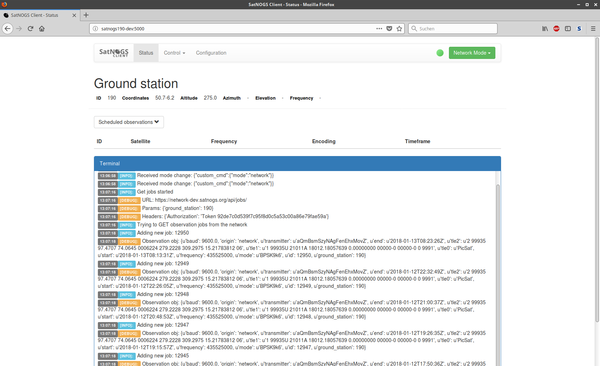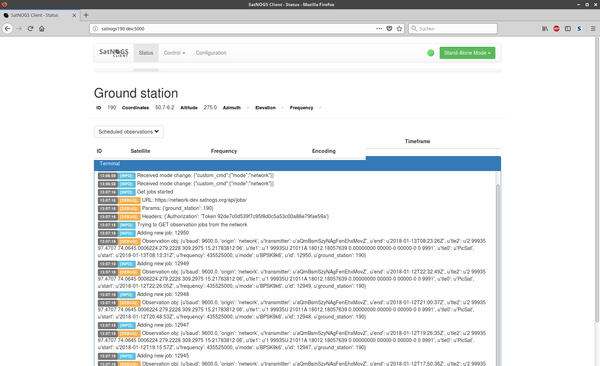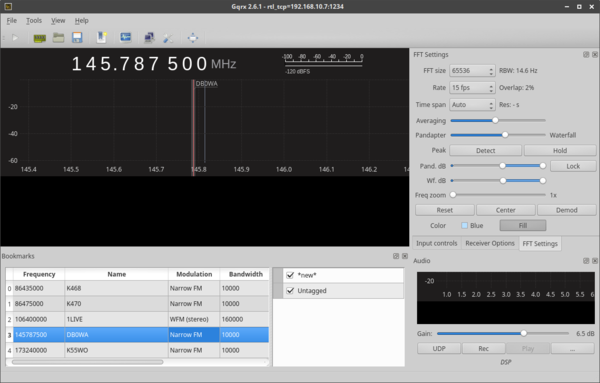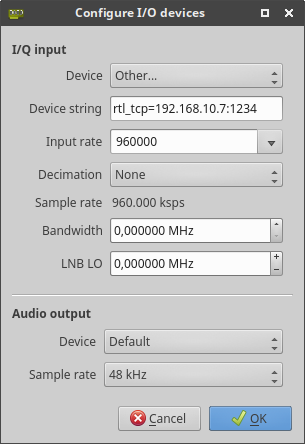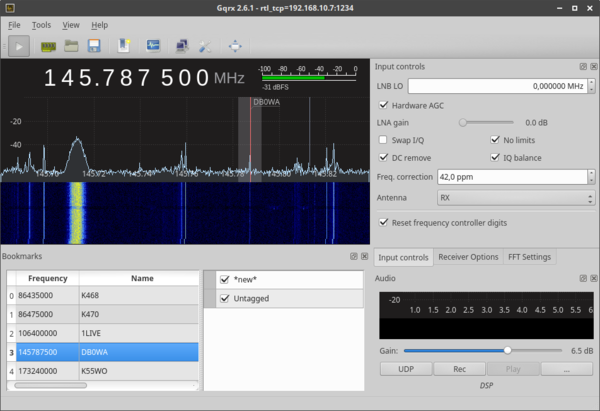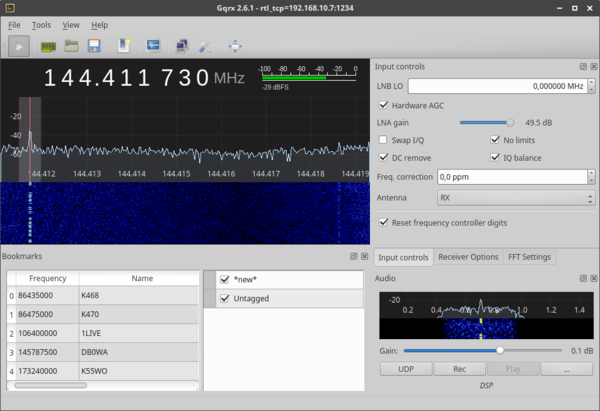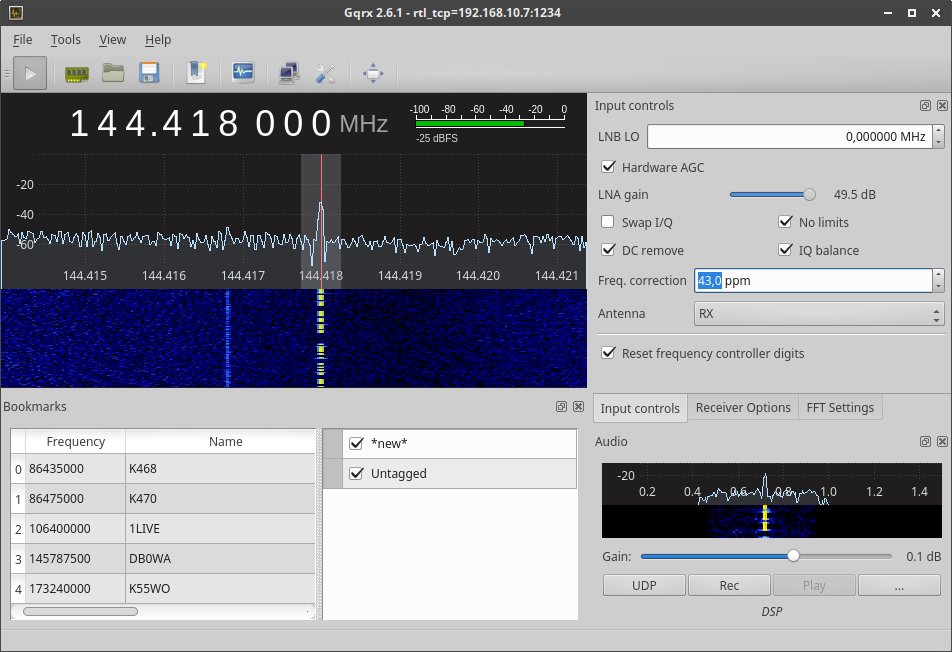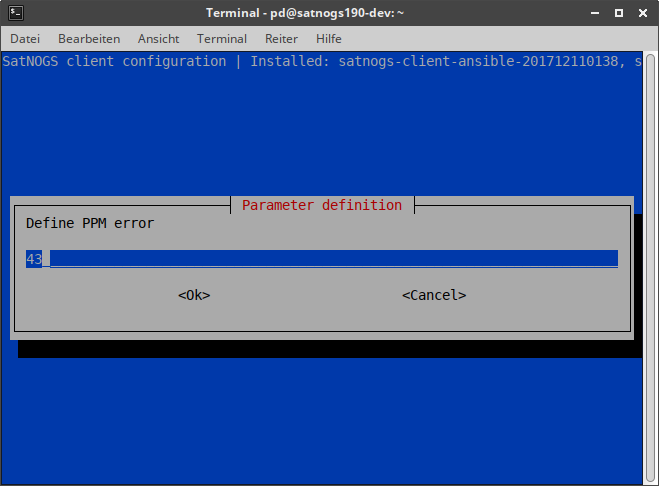Difference between revisions of "Adjusting the SatNOGS Client"
(Add screenshots from original post) |
|||
| Line 1: | Line 1: | ||
| − | (This page is a port of [https://community.libre.space/t/how-to-do-some-client-adjustments/1604/1 DL4PD's post to the SatNOGS forum.) | + | (This page is a port of [https://community.libre.space/t/how-to-do-some-client-adjustments/1604/1 DL4PD's excellent post] to the SatNOGS forum.) |
== Prerequisites / dependencies == | == Prerequisites / dependencies == | ||
| − | This page assumes | + | This page assumes: |
| − | + | * you'v read all the [[Get Started|Getting Started]] page, as well as the pages linked under "Build" and "Operate" on the [[Main Page]] | |
| + | * you have already done your [[Operation|first observations]] and you already have some waterfalls in the [[Development Environment]] | ||
| + | * you've installed [http://gqrx.dk/download install gqrx] on your local computer. | ||
== SatNOGS station adjustments == | == SatNOGS station adjustments == | ||
| − | To start | + | Now you've come to a point where you want to know how well your station is performing. The first step is to determine your frequency offset. |
| − | + | ||
| + | To start, please connect to your Raspberry Pi's local web interface. By default the URL is something like "http://192.168.0.5:5000"; you'll need to figure out what it is for your client. In the upper right corner there is a big green button where you can set your ground station in standalone mode. | ||
Here's how it looks in network mode: | Here's how it looks in network mode: | ||
| Line 24: | Line 27: | ||
* While your station is in standalone mode, no observations from the SatNOGS network will be executed!}} | * While your station is in standalone mode, no observations from the SatNOGS network will be executed!}} | ||
| − | After setting to standalone, please SSH to your SatNOGS | + | After setting to standalone, please SSH to your SatNOGS Pi with your well-known user account; by default, this is the user "pi". After successful authorization you will see a prompt like this: |
| − | known user account. | ||
| − | After successful authorization you will | ||
<pre> | <pre> | ||
| Line 71: | Line 72: | ||
Click on "Device" and chose "RTL-SDR Spectrum Server" | Click on "Device" and chose "RTL-SDR Spectrum Server" | ||
| − | Edit "Device string" to match your | + | Edit "Device string" to match your Pi's IP address, Port defaults to 1234, |
which is the same as the default setting for your server you just started on | which is the same as the default setting for your server you just started on | ||
| − | the | + | the Pi. |
Set "Input Rate" to something network friendly - we do not need the whole | Set "Input Rate" to something network friendly - we do not need the whole | ||
spectrum the RTL SDR is able to convert. 1.8 MSPS (1800000) should be OK | spectrum the RTL SDR is able to convert. 1.8 MSPS (1800000) should be OK | ||
| Line 79: | Line 80: | ||
values on average soundcards would be something like "Default, 48 kHz" | values on average soundcards would be something like "Default, 48 kHz" | ||
Close the dialogue by clicking "OK" | Close the dialogue by clicking "OK" | ||
| − | Your RTL-SDR spectrum server on the | + | Your RTL-SDR spectrum server on the Pi should now show up a connection from |
your computer running gqrx. | your computer running gqrx. | ||
| Line 138: | Line 139: | ||
You are done with frequency offset correction. | You are done with frequency offset correction. | ||
| − | + | {{Message|With gqrx, you get a nice tool to do some SDR stuff by the way. Just play around a bit and get familiar with all that stuff. Just keep in mind that, as long as you run the RTL SDR Spectrum server or you have set your client into standalone mode, nothing is done from network.}} | |
| − | Enhancements | + | == Enhancements == |
| − | Waterfall color improvements | + | === Waterfall color improvements === |
To get some nicer waterfalls one has to dig into waterfall plotting script. This is a static one and, so far, cannot be configured through satnogs-setup. Anyway: there is no magic behind it and one can understand what the changes are once you have seen them. | To get some nicer waterfalls one has to dig into waterfall plotting script. This is a static one and, so far, cannot be configured through satnogs-setup. Anyway: there is no magic behind it and one can understand what the changes are once you have seen them. | ||
| − | Log into the | + | Log into the Pi and start at making a copy of /usr/share/satnogs/scripts/satnogs_waterfall.gp, just in case: |
$ cp /usr/share/satnogs/scripts/satnogs_waterfall.gp ~/. | $ cp /usr/share/satnogs/scripts/satnogs_waterfall.gp ~/. | ||
Revision as of 15:19, 24 January 2018
(This page is a port of DL4PD's excellent post to the SatNOGS forum.)
Contents
Prerequisites / dependencies
This page assumes:
- you'v read all the Getting Started page, as well as the pages linked under "Build" and "Operate" on the Main Page
- you have already done your first observations and you already have some waterfalls in the Development Environment
- you've installed install gqrx on your local computer.
SatNOGS station adjustments
Now you've come to a point where you want to know how well your station is performing. The first step is to determine your frequency offset.
To start, please connect to your Raspberry Pi's local web interface. By default the URL is something like "http://192.168.0.5:5000"; you'll need to figure out what it is for your client. In the upper right corner there is a big green button where you can set your ground station in standalone mode.
Here's how it looks in network mode:
And here's how it looks when it's switched to standalone mode:
After setting to standalone, please SSH to your SatNOGS Pi with your well-known user account; by default, this is the user "pi". After successful authorization you will see a prompt like this:
Linux satnogs190-dev 4.9.59-v7+ #1047 SMP Sun Oct 29 12:19:23 GMT 2017 armv7l The programs included with the Debian GNU/Linux system are free software; the exact distribution terms for each program are described in the individual files in /usr/share/doc/*/copyright. Debian GNU/Linux comes with ABSOLUTELY NO WARRANTY, to the extent permitted by applicable law. Last login: Fri Jan 12 07:34:11 2018 from 192.168.10.35 pd@satnogs190-dev:~ $
Now go ahead and start the "RTL SDR spectrum server":
$ rtl_tcp -a 0.0.0.0
You will get an output like this, if everything is fine:
Found 1 device(s): 0: Generic, RTL2832U, SN: 77771111153705700 Using device 0: Generic RTL2832U Found Rafael Micro R820T tuner [R82XX] PLL not locked! Tuned to 100000000 Hz. listening...
Use the device argument 'rtl_tcp=0.0.0.0:1234' in OsmoSDR (gr-osmosdr) source to receive samples in GRC and control rtl_tcp parameters (frequency, gain, ...). No further output will be generated until you connect to this server. Hitting C-c will stop it and the command line appears. You will have to stop this server if you want to go back to network mode - do not forget about this!
Now go ahead and start gqrx:
You will have to go to the setup menu, either by clicking on the "harde" symbol, or navigating through the menu item called "File -> I/O Devices"
Click on "Device" and chose "RTL-SDR Spectrum Server" Edit "Device string" to match your Pi's IP address, Port defaults to 1234, which is the same as the default setting for your server you just started on the Pi. Set "Input Rate" to something network friendly - we do not need the whole spectrum the RTL SDR is able to convert. 1.8 MSPS (1800000) should be OK "Audio Output -> Device" and "-> Sample rate" should be set by default, values on average soundcards would be something like "Default, 48 kHz" Close the dialogue by clicking "OK" Your RTL-SDR spectrum server on the Pi should now show up a connection from your computer running gqrx.
client accepted! set gain mode 1 set agc mode 0 set direct sampling 0 Disabled direct sampling mode set offset tuning 0 set sample rate 960000 ll+, now 1 ll+, now 2 set freq correction 42 set freq 144500000 set gain mode 0 set agc mode 1 set gain 0 set freq 145814000 ll-, now 0 ll+, now 1 ll+, now 2 ll+, now 3 ll+, now 4 ll+, now 5 ll+, now 6 ll+, now 7 ll+, now 8 ll+, now 9 ll+, now 10 ll+, now 11 ll+, now 12 ll+, now 13
The only thing left now is to "Start DSP" - from the menu item "File", by hitting C-d or simply clicking the Play-Button.
Go for a known local HAM radio repeater or a CW beacon transmitter and set your demodulator accordingly. Narrow Band FM or CW is best to discover ppm error offset, which is the frequency offset in parts per million (ppm) which is always there with standard RTL-SDR dongles. It is also highly temperature dependent, so one might have to re-evaluate this from time to time. Enter the known frequency of your chosen transmitter (NFM repaeter or CW beacon). I have chosen a very known CW beacon just some km away from my home: ON4VHF on 144.718000 MHz. Walk through the tab called "Receiver options" and change the settings to fit the beacon: "Filter width Normal", "Filter shape Normal", "Mode CW-L", "AGC Medium". Set Squelch to something low, so you can hear noise from your speakers. Maybe you have to Adjust the audio "Gain" to something like "0.0 dB". You can adjust this to fit your needs to hear noise. With ppm error, which is default, set to 0.0 ppm, one can just guess where your receiver is listening. Anyway, just set it to 144.718000 MHz and try to find your beacon. You can see the result for my RTL SDR dongle down here:
Now got to the tab called "Input controls" and find an input field called "Freq. correction". By default this should show "0,0 ppm". Set frequency back to your beacons transmit frequency. After this you have to increase the Freq. correction value as long until you can hear the beacon. Now zoom into the panorama by locating your mouse pointer in the range where the frequency values are printed below the panorama, just above the waterfall. Try to fit the Freq. correction value as good as possible, that your receivers red indication line is just in the middle of the transmitters bandwidth.
Now write down the evaluated ppm correction value and exit gqrx as well as the RTL SDR spectrum server. In the command line now available start satnogs-setup:
$ sudo satnogs-setup
Navigate to "Advanced -> SATNOGS_PPM_ERROR" and enter the new value.
Exit the satnogs-setup with "Back", then "Apply Configuration" (this might take a while) and "Back".
You are done with frequency offset correction.
Enhancements
Waterfall color improvements
To get some nicer waterfalls one has to dig into waterfall plotting script. This is a static one and, so far, cannot be configured through satnogs-setup. Anyway: there is no magic behind it and one can understand what the changes are once you have seen them.
Log into the Pi and start at making a copy of /usr/share/satnogs/scripts/satnogs_waterfall.gp, just in case:
$ cp /usr/share/satnogs/scripts/satnogs_waterfall.gp ~/.
Now you can start editing the script:
$ sudo nano /usr/share/satnogs/scripts/satnogs_waterfall.gp
Search for a line starting with cbtics:
# Spectravue palette and scale set cbtics (-110, -105, -100, -95, -90, -85, -80, -75, -70, -65, -60, -55, -50, -55, -40)
Comment it out by adding a #, copy, paste and edit that new line that it matches something like this:
# Spectravue palette and scale #set cbtics (-110, -105, -100, -95, -90, -85, -80, -75, -70, -65, -60, -55, -50, -55, -40) set cbtics (-90, -85, -80, -75, -70, -65, -60, -55, -50, -55, -45, -40, -35, -40, -25)
Now go ahead and find a line with cbrange:
set ylabel 'Time (seconds)' set cbrange [-100:-50]
I guess, one already gets the point - change cbrange to match the new cbtics:
set ylabel 'Time (seconds)' #set cbrange [-100:-50] set cbrange [-85:-35]
Save the file and you are done. Schedule some observations and watch the new colors. Maybe you can just improve it a little more but keep in mind: always keep a bit of the noise floor into the waterfalls, so you can see the whole signals dynamic range. I love it, when there are only a few dots of the noise.
